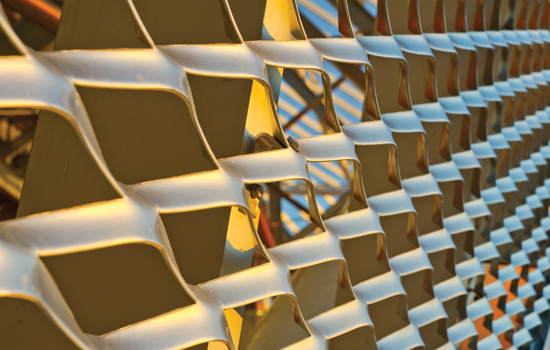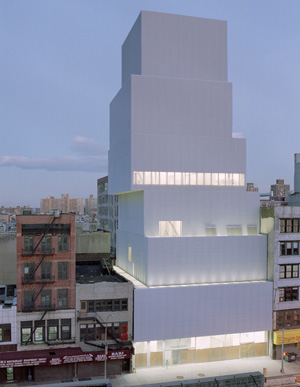Expanded Metal Mesh in Architecture
Industry Standards
Since expanded metal mesh has been available for quite some time, the industry has matured and standards have been developed regarding this product. As would be expected, it is the National Association of Architectural Metal Manufacturers (NAAMM) that has advanced and promoted those industry standards. In fact, they have gone so far to establish a separate division of NAAMM known as the Expanded Metal Manufacturers Association (EMMA) Division.
NAAMM standard EMMA 557-12 was published in 2012 under the title of “Standards for Expanded Metal.” It introduces the material, offers some product selection considerations, defines industry terminology, describes the manufacturing process, reviews manufacturing tolerances, and offers some application information. Among the most basic information, the following terms are important to understand from this standard.
 |
Expanded metal mesh is created by slitting and stretching flat sheet metal to create diamond shaped openings with virtually no waste. Photo courtesy of AMICO |
Expanded Metal — A rigid piece of metal which has been slit and drawn into an open mesh pattern in a single operation. Conventional mesh is formed in a diamond pattern.
Diamonds — Open area of metal after expanding. Most expanded metal patterns are diamond shaped but may also be hexagonal, louvered, asymmetric, etc.
Design Designations —
SWD. Nominal dimension, Short Way of Diamond.
LWD. Nominal dimension, Long Way of Diamond.
Design size. Actual dimension SWD and LWD. Measured from a point to a corresponding point on the adjacent diamond.
SWO. Short Way of Opening.
LWO. Long Way of Opening.
Strands. The sides of the expanded metal design.
Strand thickness. Thickness of the base metal.
Strand width. Amount of metal fed under dies to produce one strand.
Strand thickness and width. Can be varied to create different openings. The width of the strand should equal or exceed the thickness of the base metal.
 |
The outer skin of the New Museum of Contemporary Art in New York City is clad in expanded metal. The bright aluminum surface catches the light reflecting the changing moods every day throughout the year. Photo by SANAA Architects, courtesy of AMICO |
Bond — Intersection of two strands.
Fine Mesh — A precise, miniature version of standard expanded metal with SWD openings measuring under 0.140 inch (3.55 mm). Material as thin as 0.002 inch (0.05 mm) can be expanded. Available in a variety of metals and alloys including gold, silver, and platinum, they are often used for retaining filtration material, custom decoration for small appliances, and as battery electrodes.
Edge Configuration — The condition of the edge of an expanded metal sheet. This designation usually refers to “open” (random) or “closed” (bond) diamond edges produced from shearing.
Expanded metal mesh is often referred to by different styles. Standard (S) or Regular (R) expanded metal is mesh as it comes from the press. The strands and bonds are set at a uniform angle to the plane of the sheet.
Standard expanded metal offers high rigidity in a variety of sizes and weights. The angles of the diamond strands allow maximum air circulation and distribute stress on the metal to supporting frames. By contrast, Flattened (F) expanded metal is mesh that has been cold-rolled after expansion, to provide a smooth, flat, and level sheet. The flattening process reduces the original thickness of the base metal. Flattened expanded metal is used in a variety of specialty applications, such as lawn furniture, book and storage shelves, lamps and lamp shades, fireplace screens, many types of grilles, occasional tables, folding screens, room dividers, and air filtration filters.
Architectural or decorative meshes are also identified as an industry category of expanded metal mesh and are used to provide privacy, reduce air conditioning requirements, and to control light and air while allowing visibility. Sun screens, room dividers, and building facades are only a few of the design possibilities.
Decorative meshes are available in many styles and weights, ranging from delicate thin-strand designs to heavier patterns which approximate the appearance of considerably more expensive cast and wrought iron products.









